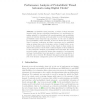CONCUR
1999
Springer
14 years 7 months ago
1999
Springer
Abstract. The paper presents a partial order reduction method applicable to networks of timed automata. The advantage of the method is that it reduces both the number of explored c...
ARTS
1999
Springer
14 years 7 months ago
1999
Springer
In this paper we study the issue of progress for distributed timed systems modeled as the parallel composition of timed automata. We clarify the requirements of discrete progress (...
STACS
2001
Springer
14 years 7 months ago
2001
Springer
Using an automata-theoretic approach, we investigate the decidability of liveness properties (called Presburger liveness properties) for timed automata when Presburger formulas on ...
FM
2001
Springer
14 years 7 months ago
2001
Springer
To develop efficient algorithms for the reachability analysis of timed automata, a promising approach is to use binary decision diagrams (BDDs) as data structure for the representa...
CAV
2001
Springer
14 years 7 months ago
2001
Springer
In this paper we show how the classical job-shop scheduling problem can be modeled as a special class of acyclic timed automata. Finding an optimal schedule corresponds, then, to n...
FM
2009
Springer
14 years 7 months ago
2009
Springer
We study a clock synchronization protocol for the Chess WSN. First, we model the protocol as a network of timed automata and verify various instances using the Uppaal model checker...
HYBRID
2003
Springer
14 years 8 months ago
2003
Springer
The algorithmic analysis of timed automata is fundamentally limited by the undecidability of the universality problem. For this reason and others, there has been considerable inter...
FORMATS
2003
Springer
14 years 8 months ago
2003
Springer
Probabilistic timed automata, a variant of timed automata extended with discrete probability distributions, is a specification formalism suitable for describing both nondeterminis...
FORMATS
2003
Springer
14 years 8 months ago
2003
Springer
This text is dedicated to modelling of real-time applications running under multitasking operating system. Theoretical background is based on timed automata by Alur and Dill. As th...
FORMATS
2003
Springer
14 years 8 months ago
2003
Springer
Timed automata are known not to be complementable or determinizable. Natural questions are, then, could we check whether a given TA enjoys these properties? These problems are not...


